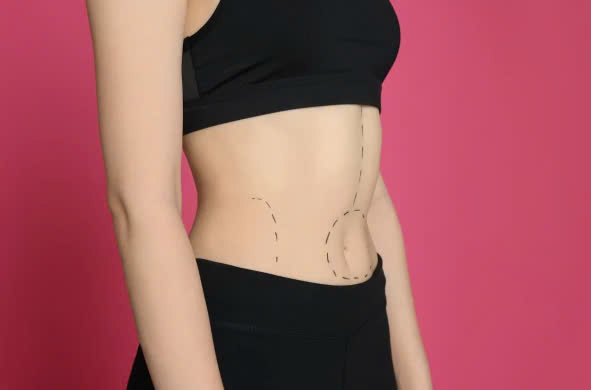Contents
- 1 Skin Elasticity and Its Role in Body Transformation
- 2 Understanding Loose Skin and Its Causes
- 3 How Much Weight Loss Can Lead to Lose Skin?
- 4 The Benefits of Gradual and Sustainable Weight Loss
- 5 Nutrition Strategies for Skin Health During Weight Loss
- 6 The Role of Strength Training in Preventing Loose Skin
- 7 Final Thoughts on Loving and Caring for Your Body at Every Stage
Skin Elasticity and Its Role in Body Transformation
Sustainable weight loss helps the body progressively adjust to size changes, therefore preventing slack or sagging skin. If weight is lost too rapidly, excess skin might be challenging to control since hardly enough time is left to shrink and correct. Skin elasticity responds to body changes over time depending on collagen and elastin. Quick weight reduction could aggravate the issue by lowering nutrients required for skin elasticity. Regular exercise, a good diet, enough hydration, and a slow, balanced weight loss program help to preserve skin and beauty.
Body change depends on knowledge of skin elasticity, particularly how to avoid loose skin after weight loss. Collagen and elastin are what enable skin elasticity to stretch and restore original form. Poor diet, major weight changes, and aging can all lower skin elasticity, thereby making retraction challenging. Gradually drop weight to provide the body time to adapt and prevent loose skin following weight loss. Wondering what happens when you stop taking sermorelin and get back to your previous lifestyle? After weight loss, strength training to build muscle, a nutrient-dense diet with vitamins C and E, keeping hydrated, and regular skincare routines will assist the skin’s natural suppleness be supported.
Understanding Loose Skin and Its Causes
Because the skin cannot shrink back fast enough to fit the body’s new form, rapid weight loss sometimes results in loose skin. Older people especially find this prevalent since age-related losses in collagen and elastin generation over time lower the suppleness of the skin. Adopting a slow and sustained weight loss strategy will help to allay the worry about how to avoid loose skin after weight loss by giving the skin enough time to respond. Strength training activities can assist build muscle, which gives the skin a sturdy basis. Further supporting skin health and elasticity is keeping appropriate hydration and a balanced diet high in collagen-boosting elements like vitamin C and protein.
Skin elasticity and tightness are mostly determined by genes since individual variations in collagen generation, skin thickness, and natural aging processes define these parameters. While some people may have a hereditary inclination to have firm skin even after weight loss, others may find their skin more easily loosens. Moreover, over time weight cycling—also known as yo-yo dieting—can compromise skin health and suppleness. Repeated cycles of fast weight loss and weight gain stretch the skin and lower its capacity to repair correctly, therefore increasing the probability of sagging and loose skin. Preserving skin tightness and general health so depends on keeping a constant, healthy weight.
How Much Weight Loss Can Lead to Lose Skin?
Weight loss, especially rapid or considerable weight reduction, can cause loose skin. Age, skin flexibility, weight loss, and duration all affect loose skin risk. Skin elasticity may reduce sagging in younger people. Skin adaptation is also affected by genetics and moisture. Gradual weight loss, a nutritious diet rich in collagen-boosting nutrients, staying hydrated, and strength training to build muscle and improve skin tone can be the solution on how to avoid loose skin after weight loss.
Over time, rapid or dramatic weight shifts can damage skin. Skin expands to accommodate weight growth. Due to reduced elasticity, the skin may struggle to retract entirely after significant or frequent weight loss, especially above 50 to 100 pounds. Age, weight gain length, and weight loss pace affect skin resiliency. Prolonged stretching weakens collagen and elastin, making big weight shifts more likely to cause loose skin. Gradual modifications, supportive skin care, and muscle-building workouts can reduce these consequences.
The Benefits of Gradual and Sustainable Weight Loss
Gradually decreasing weight can help to preserve skin elasticity and lower the possibility of loose skin. Quick weight loss leaves excess skin that’s difficult to control since it prevents the skin from shrinking with the body. Gradual weight loss facilitates the skin’s response to the shifting body form. Additionally helping to increase skin suppleness is staying hydrated, consuming meals high in collagen, and strength training. Patience, suitable skincare, and consistent lifestyle choices are absolutely vital for long-term changes and knowledge about how to avoid loose skin after weight loss.
Health experts support safely shedding one to two pounds every week. More sustainable and allows the body to adjust without compromising muscle mass or nutrients is this moderate weight loss. Quick weight loss can lead to lose skin, nutrient deficits, and muscular loss. Exercise and a balanced diet can produce consistent, sensible weight loss most likely to last.
Especially in weight loss, keeping muscle mass helps preserve skin tightness. People who lose weight too rapidly without enough muscle retention may find their skin loosening. Strength training increases skin suppleness by helping muscles mass to be built and maintained. Diet high in proteins and vital nutrients helps muscles and skin repair. Enough hydration, moderate weight reduction, and consistent strength training can help skin elasticity increase and giving the opportunity on how to avoid loose skin after weight loss.
Nutrition Strategies for Skin Health During Weight Loss
Skin suppleness needs certain nutrients. Lean meats, seafood, and bone broth’s amino acids increase collagen synthesis, thereby preserving skin’s firmness. Vitamin C and E among other antioxidants help to synthesize collagen and shield the skin from free radical damage. Hydration preserves suppleness by maintaining the moisture barrier of the skin and by preventing dryness. A balanced diet and enough water give bright, smooth skin.
Especially with weight loss, protein helps muscles and skin stay strong. Enough high-quality protein helps tissues grow and heal, maintaining skin elasticity and muscular mass. Amino acids in eggs, chicken, and beans build collagen for strong skin. Eat enough protein and strength workout to keep muscles and tone after weight loss. This mix is a part of strategy on how to avoid loose skin after weight loss.
Some nutrients boost collagen formation and skin firmness, which helps you to seem younger. Production of collagen calls for citrus, bell peppers, and strawberries’ vitamin C. Zinc found in shellfish, pumpkin seeds, and nuts helps collagen to be rebuilt. Bone broth has proline, glycine, and collagen—all of which are essential for good skin. Spinach and kale high in antioxidants protect collagen against free radicals. Over time, nutritionally balanced meals can help skin elasticity and firmness improve.
The Role of Strength Training in Preventing Loose Skin
Particularly following major weight loss, building muscle can be a great strategy to help fill in loose skin. Increasing muscle mass gives the skin structure and stability under which it loses flexibility from fast changes in body composition, so giving it a firmer look. By encouraging muscle growth and hence increasing general tone, strength training activities such weightlifting can target particular areas of concern. Combining slow weight loss plans with muscle-building exercises helps to preserve skin elasticity and prevent too severe sagging, solving the problem how to avoid loose skin after weight loss. Concentrating on food and exercise helps people to solve the problems of loose skin and get a more defined, healthy body.
A good approach to get balanced fat reduction and general fitness is combining strength training with cardio. Lean muscle mass gained from strength training raises the body’s resting metabolic rate and encourages fat burning even beyond the end of the activity. Conversely, aerobic activities include swimming, cycling, or running help effectively burn calories, thereby strengthening heart health and endurance. Combining both kinds of exercise into a regimen allows people to target fat loss while either keeping or even building muscle mass, therefore producing a leaner, more toned body. This all-around strategy improves looks as well as aids weight control and long-term health.
Final Thoughts on Loving and Caring for Your Body at Every Stage
Loss of weight should be done gradually and steadily to prevent loose skin. While steady loss preserves suppleness, quick weight loss leaves the skin too little time to respond. Strength training and resistance exercises help build muscular mass that will tighten skin. Eat protein and keep hydrated to preserve skin health and elasticity. Good skincare—including moisturizing—can also help to support skin resiliency. Recall that long-term effects depend on sustainable actions; so, balance your weight reduction. Learning how to avoid loose skin after weight loss and giving your health top priority will help you lose weight happier and healthier.
Lastly, loving and caring for your body at every level depends mostly on self-compassion and gratitude. Over time, your body changes and presents fresh challenges. Celebrate the power, resiliency, and abilities of your body rather than its shortcomings. Remember that beauty and value are not arbitrary; hence, give self-care supporting your mental and physical health top priority. Being gentle to your body, listening to its needs, and appreciating its story will help you to improve your relationship with yourself.







